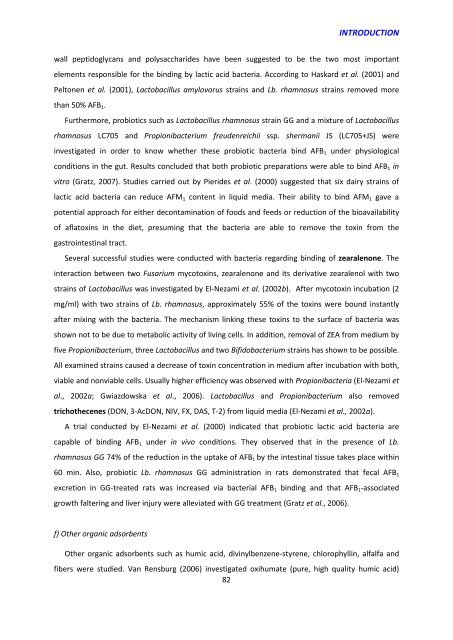Effet chez le porcelet d'une exposition à un régime co-contaminé en ...
Effet chez le porcelet d'une exposition à un régime co-contaminé en ...
Effet chez le porcelet d'une exposition à un régime co-contaminé en ...
You also want an ePaper? Increase the reach of your titles
YUMPU automatically turns print PDFs into web optimized ePapers that Google loves.
INTRODUCTIONwall peptidoglycans and polysaccharides have be<strong>en</strong> suggested to be the two most importante<strong>le</strong>m<strong>en</strong>ts responsib<strong>le</strong> for the binding by lactic acid bacteria. Ac<strong>co</strong>rding to Haskard et al. (2001) andPelton<strong>en</strong> et al. (2001), Lactobacillus amylovorus strains and Lb. rhamnosus strains removed morethan 50% AFB 1 .Furthermore, probiotics such as Lactobacillus rhamnosus strain GG and a mixture of Lactobacillusrhamnosus LC705 and Propionibacterium freud<strong>en</strong>reichii ssp. shermanii JS (LC705+JS) wereinvestigated in order to know whether these probiotic bacteria bind AFB 1 <strong>un</strong>der physiological<strong>co</strong>nditions in the gut. Results <strong>co</strong>ncluded that both probiotic preparations were ab<strong>le</strong> to bind AFB 1 invitro (Gratz, 2007). Studies carried out by Pierides et al. (2000) suggested that six dairy strains oflactic acid bacteria can reduce AFM 1 <strong>co</strong>nt<strong>en</strong>t in liquid media. Their ability to bind AFM 1 gave apot<strong>en</strong>tial approach for either de<strong>co</strong>ntamination of foods and feeds or reduction of the bioavailabilityof aflatoxins in the diet, presuming that the bacteria are ab<strong>le</strong> to remove the toxin from thegastrointestinal tract.Several successful studies were <strong>co</strong>nducted with bacteria regarding binding of zeara<strong>le</strong>none. Theinteraction betwe<strong>en</strong> two Fusarium my<strong>co</strong>toxins, zeara<strong>le</strong>none and its derivative zeara<strong>le</strong>nol with twostrains of Lactobacillus was investigated by El-Nezami et al. (2002b). After my<strong>co</strong>toxin incubation (2mg/ml) with two strains of Lb. rhamnosus, approximately 55% of the toxins were bo<strong>un</strong>d instantlyafter mixing with the bacteria. The mechanism linking these toxins to the surface of bacteria wasshown not to be due to metabolic activity of living cells. In addition, removal of ZEA from medium byfive Propionibacterium, three Lactobacillus and two Bifidobacterium strains has shown to be possib<strong>le</strong>.All examined strains caused a decrease of toxin <strong>co</strong>nc<strong>en</strong>tration in medium after incubation with both,viab<strong>le</strong> and nonviab<strong>le</strong> cells. Usually higher effici<strong>en</strong>cy was observed with Propionibacteria (El-Nezami etal., 2002a; Gwiazdowska et al., 2006). Lactobacillus and Propionibacterium also removedtrichothec<strong>en</strong>es (DON, 3-AcDON, NIV, FX, DAS, T-2) from liquid media (El-Nezami et al., 2002a).A trial <strong>co</strong>nducted by El-Nezami et al. (2000) indicated that probiotic lactic acid bacteria arecapab<strong>le</strong> of binding AFB 1 <strong>un</strong>der in vivo <strong>co</strong>nditions. They observed that in the pres<strong>en</strong>ce of Lb.rhamnosus GG 74% of the reduction in the uptake of AFB 1 by the intestinal tissue takes place within60 min. Also, probiotic Lb. rhamnosus GG administration in rats demonstrated that fecal AFB 1excretion in GG-treated rats was increased via bacterial AFB 1 binding and that AFB 1 -associatedgrowth faltering and liver injury were al<strong>le</strong>viated with GG treatm<strong>en</strong>t (Gratz et al., 2006).f) Other organic adsorb<strong>en</strong>tsOther organic adsorb<strong>en</strong>ts such as humic acid, divinylb<strong>en</strong>z<strong>en</strong>e-styr<strong>en</strong>e, chlorophyllin, alfalfa andfibers were studied. Van R<strong>en</strong>sburg (2006) investigated oxihumate (pure, high quality humic acid)82

















